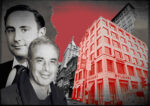Trending
At 220 CPS, Steve Roth is the bouncer

Douglas Elliman’s Jacky Teplitzky and her wealthy client couple were seated in the sales office at 220 Central Park South when an unexpected visitor showed up: Steve Roth.
Roth didn’t introduce himself as he sauntered in. He is, after all, an industry legend, the head of an $18 billion-plus real estate company, and the guy who’s building the luxury condominium tower Teplitzky’s clients wanted to buy into. But they didn’t know him from Adam.
He began asking questions of the couple, seeming less interested in their finances than their background and personalities.
“It’s just bizarre because you don’t have many people asking personal questions like that,” Teplitzky recalled.
After a few minutes, Roth excused himself. Later, after the meeting was over, Teplitzky asked her clients: “Do you realize this was the owner of the building?”
Teplitzky thought Roth’s cameo was a one-off. But she later had more meetings at the sales office with different clients, and Roth showed up every single time. Other brokers told similar stories.
“He’s basically hand-picking the buyers in his building,” Teplitzky said. “He’s almost like ‘this is a private home’ and he is treating it as such. He really wants to see and meet every single person.”
Roth’s personal involvement in vetting buyers, corroborated by several sources, is just one of the many strange aspects of 220 CPS’ sales process.
“I’ve never seen anything marketed like this in my whole entire career,” said one broker, speaking on condition of anonymity. Leonard Steinberg, president of Compass, described the approach as “reminiscent of a co-op board interview.”
Unlike other New York luxury condos currently under construction, 220 CPS doesn’t have a public website. Brokers who want to secure a meeting at the sales office are sent a questionnaire about their client.
The form, which brokers liken to a mini-bio, includes questions about background, income and wealth, say sources who have seen it. It is highly unusual in a field where developers go out of their way to respect the privacy of potential buyers.
If buyers get through the questionnaire without raising red flags, they are invited to the sales office. Anyone who has been to a sales office for a tower of this caliber would likely picture glitzy model kitchens, a scale replica of the tower, tasteful art dotting the walls, hors d’oeuvres and perhaps a virtual reality headset. But at 220 CPS, what you get is a nondescript room inside Vornado’s headquarters: It’s got a couch, a table and a computer screen.
“It looks like a living room,” Teplitzky said. Roth insists that potential buyers personally show up. As one broker points out, this isn’t always easy for those who live overseas or those who want to keep their identities under wraps.
Leaving a good impression on the CEO is the next hurdle to cross. Nikki Field, a broker at Sotheby’s International Realty, said Vornado rejected at least three of her firm’s wealthy clients without explanation. Another broker said that clients who balk at the onerous vetting process have now set their sights on competing condos like One57 and 432 Park Avenue.
Why is Roth so picky about his buyers? Representatives for the project declined to comment. But some brokers draw a connection to the recent New York Times investigation into foreigners with shadowy sources of wealth buying luxury apartments at the Related Companies’ Time Warner Center. Roth, they speculate, wants to avoid that kind of bad press — perhaps even more so since this is the firm’s First Residential Development Project Since One Beacon Court in 2004.
“Maybe they want to make sure the money is legitimate,” said Olshan Realty’s Donna Olshan. The process also allows Vornado to ensure buyers actually can afford an apartment, said Town Residential’s Michelle Bourgeois. Prices at the building range from just under $5,000 per square foot to over $10,000 a foot.
Some brokers believe that turning away potential buyers can be a shrewd marketing strategy. By positioning 220 CPS as an exclusive private club where wealth alone won’t get you in, Vornado makes the building something to covet. Think of it as Mrs. Astor’s 400 for the new gilded age.
“That which is not available to everyone is the thing people want most,” Steinberg said. Already, the building has at least one apartment in contract for north of $200 million, reportedly to hedge fund billionaire Ken Griffin.
The minimalistic sales office, too, could be a way of playing hard-to-get. Surely, visitors may think, a company that puts so little effort into wooing must have buyers already lining up.
But are they? Turning away buyers could work if you’re confident there’s plenty more where they came from. Time will tell if that’s the case.
Last year Vornado announced the tower had sold $1.1 billion worth of units in just six weeks (its latest projected sellout is $3.17 billion), but has since been reluctant to release new information. When an analyst asked Roth for an update on sales during a February earnings call, he flatly declined. “I don’t think it’s good for our business to give these kinds of minute details,” he said. “It doesn’t help us. It hurts us competitively in the market. The market is slowing. It’s slowing for everybody. It’s slowing a little bit less for us, but of course it’s slowing for us as well.”
The picture appears to have improved in recent months amid a broader recovery of luxury apartment sales. In early June Roth noted 220 CPS’ sales office “is noticeably busier than it was three months ago.” For him, that means more interrogations of buyers.




